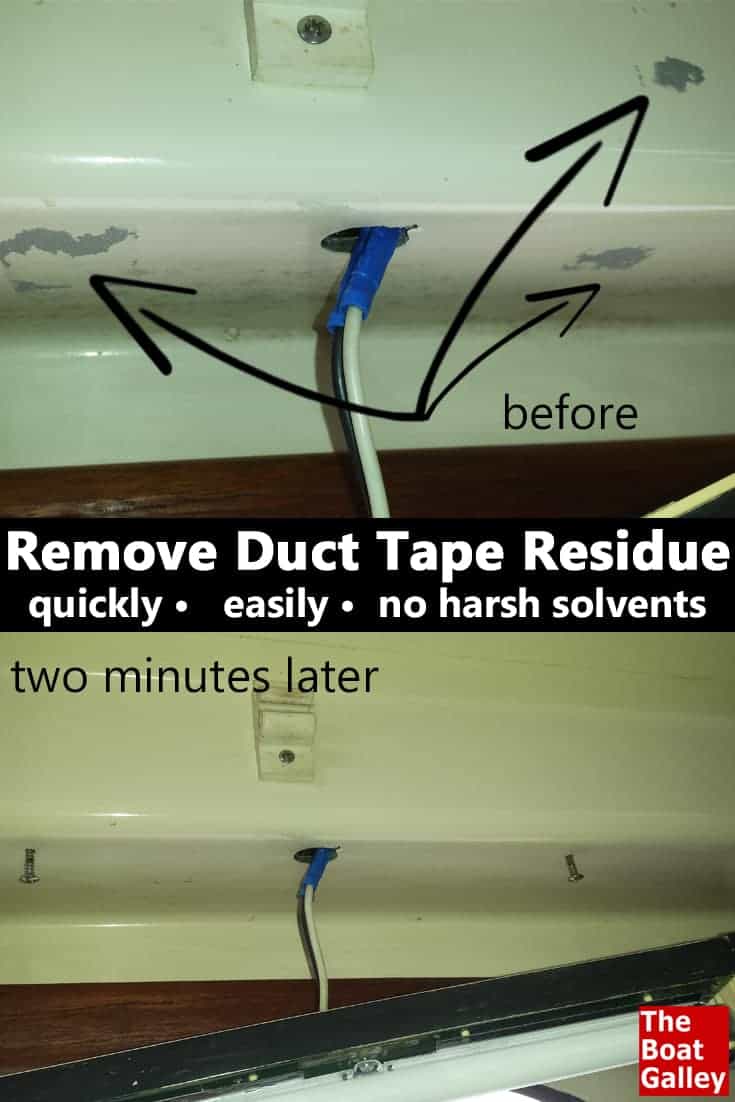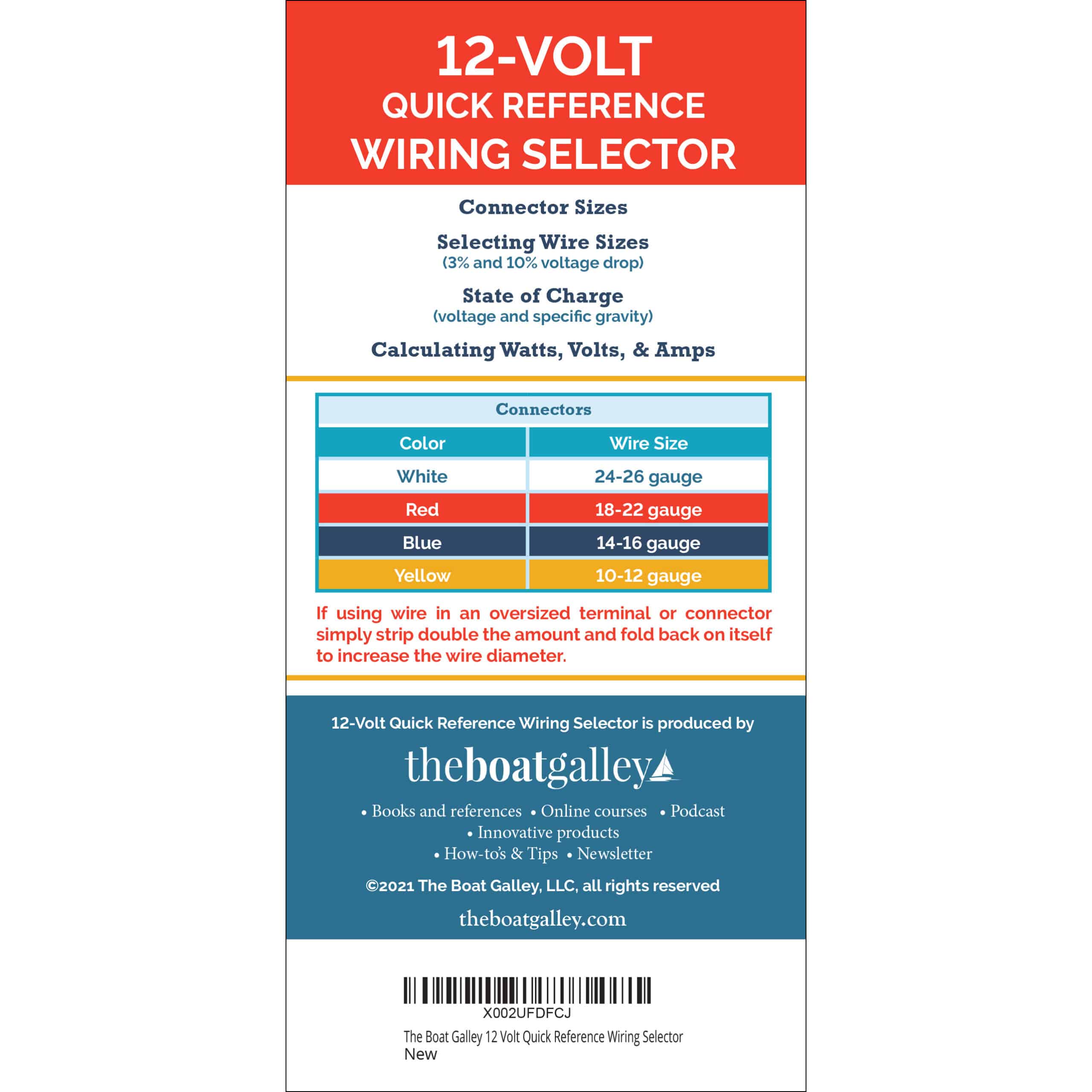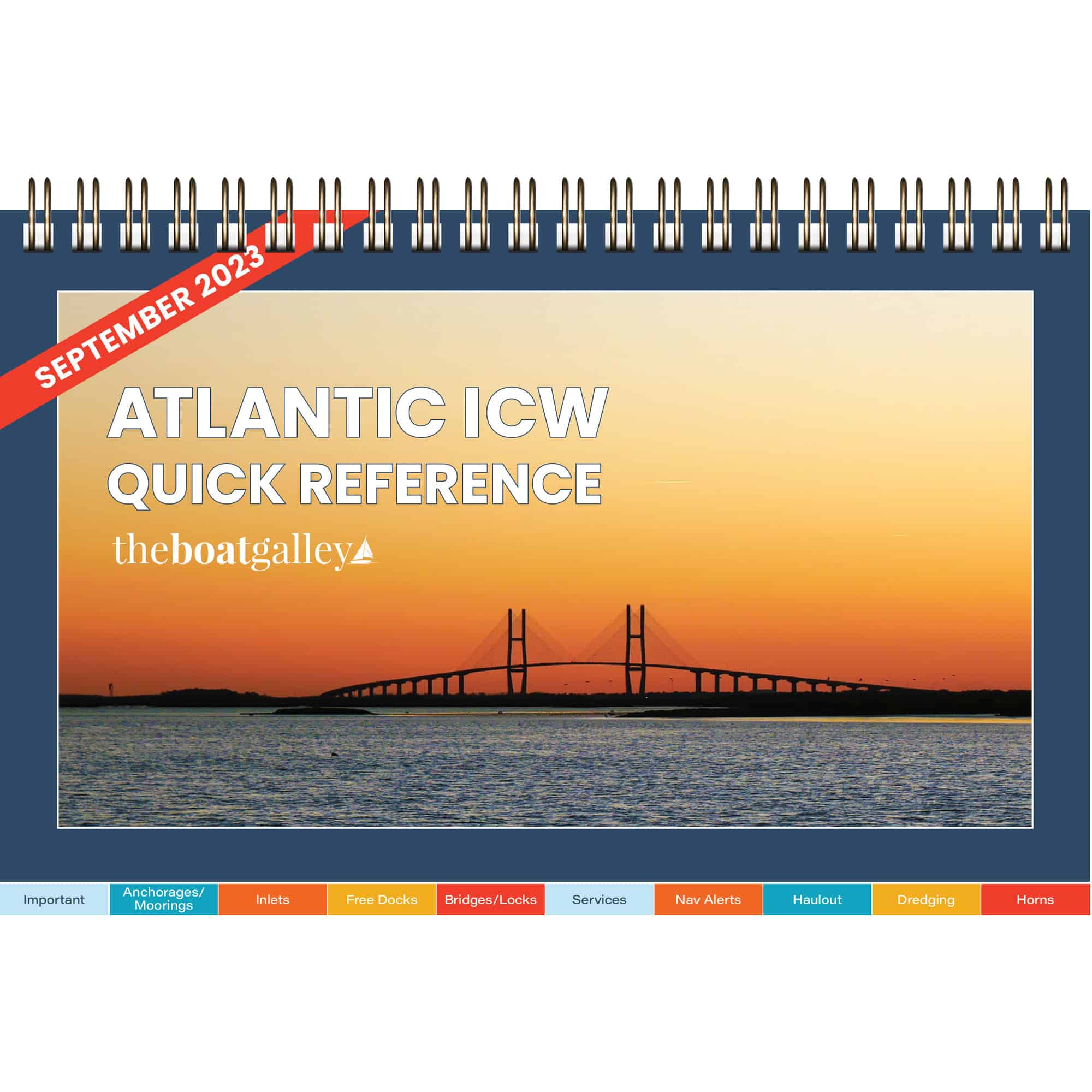Duct tape — or Gorilla Tape — is great for lots of things, but it’s not known for coming off cleanly, particularly if it’s been hot.
I used to use acetone, then I switched to Goo Gone. About five years ago, a contractor friend of ours said to use WD-40 — he swore it was better and much cheaper.
Since then, that’s what we’ve used. And he was right — it easily removes tape residue that took forever with Goo Gone.
Use a rag with a bit of texture to it — for example, terry cloth as opposed to an old t-shirt — and soak a small area of it with WD-40, then scrub at the residue. If there is a lot of tape gunk to get off and nothing nearby that the WD-40 would hurt if it ran or dripped, you can spray the residue and let it sit for just a minute before scrubbing.
Obviously, don’t do this on anything that the oil in WD-40 would harm! After removing the residue, I usually use a bit of soap and warm water to wash the area so it’s not slick from the WD-40. It’s really important to wash the WD-40 off if you’ve gotten it anywhere that people will walk as it is extremely slippery.
NOTE: Some people prefer to use Gaffer’s Tape to duct tape because it leaves far less residue. That’s true — it’s wonderful tape — but it’s also much more expensive than duct tape or even Gorilla Tape. We prefer to save it for times when we really need the “leave no residue” feature (see Gaffer’s Tape on Amazon if you’re not familiar with it — we weren’t until a reader recommended it).

Carolyn Shearlock has lived aboard full-time for 17 years, splitting her time between a Tayana 37 monohull and a Gemini 105 catamaran. She’s cruised over 14,000 miles, from Pacific Mexico and Central America to Florida and the Bahamas, gaining firsthand experience with the joys and challenges of life on the water.
Through The Boat Galley, Carolyn has helped thousands of people explore, prepare for, and enjoy life afloat. She shares her expertise as an instructor at Cruisers University, in leading boating publications, and through her bestselling book, The Boat Galley Cookbook. She is passionate about helping others embark on their liveaboard journey—making life on the water simpler, safer, and more enjoyable.
Your VHF can do so much! Learn how to use ALL its features for just $39:












Jim Shell says
We use “De Solve It” for adhesive removal. It is an orange oil product that smells good. Orange solvent works well, too.
Jeff Kear says
Had a leaky sun roof on my 2001 Nissan micra, and used a plastic sheet and waterproof gutter tape from Lidl. Bad moove! I’ve tried everything to remove the film after removing tape a month later. Nothing has touched it… Nothing listed here and a lot of other things too.
This was 2 years ago, you’d think the sun would have helped peel it but nope, I’m stuck with it. Bah!
Left with a horrid inch wide strip round the roof light, sure there must be some solvent out there that would melt it with out taking the paint off too, any suggestions, Thanks, Jeff.
Bill S P Parker says
We use trichloethylene or other chlorinated alkenes. It leaves no residue and avoids the explosion risk of using acetone or ethyl acetate (nail polish remover) both of which remove the plasticiser from gel coat and polyester resins. WD 40 (a composition of fish oils) works well, if more slowly but it does yellow white gel coat. Our web site advertises ‘Scavenger’ a cleaning agent designed for cleaning fouled rubber and plastic and comprising a mixture of fatty acid ethoxylates- completely benign to surfaces and strong enough to dissolve even raw, polyester resin….but chlorinated alkanes and alkenes are faster and equally, non-flammable.
Scott Schreiber says
Just a note: WD40 contains NO fish oils. This is urban legend. So sorry to de-romanticize the allure….
Don Sanders says
WD40 is simply kerosene in an aerosol form. Much cheaper to buy a bottle from the supermarket of kero and get all the other de-greasing benefits – remember WD40 is mainly used for cleaning car engines. And NEVER use WD40 to loosen up door locks – it is an oil and will attract dust like a magnet. Don
pmshah says
Not only that kerosene cleaned steel items will oxidise and corrode super fast. Avoid its use as far as possible. Also its smell is as good as impossible to remove.
brad says
We use a product from Real Goods – wife works there, so convenient – called Sticky Bye-Bye. Other than the silly name, pretty good stuff. Need to try it on that cooked gunk from the car sale sticky gunk on the car window…..
THAT would be a test. In the past have used Goof-Off and had good luck. Prefer to NOT use petrochemicals if possible. They are all pretty much carcinogenic and/or endocrine (hormone hell) disruptors – and if you use petro (plastic) in a microwave you vastly increased the carcinogenic and hormonal damages. Plus killed over 70% of your nutrition. Kinda like buying a hundred dollars of food, and throwing $30 away.
Not Brad says
There are reasons you shouldn’t microwave food in plastic containers, but claiming you “killed over 70% of your nutrition” is ridiculous, and makes any of the rest of your statements nonsense by association.
Bill Wakefield says
Hi Carolyn,
Earlier this year I spotted a ‘low residue’ duct tape [3M Scotch Brand] in a local box store. We tried it and it is true; no goo upon removal [for up to 6 months according to manufacturer…] and it is really high quality, tenacious, waterproof tape. I’ve seen it on the shelves in dark grey and transparent ‘colors.’ It is the only duct tape on board now [aside from the wide Gorilla tape…]
It sells for about the same as other premium duct tapes [~$11/large roll] and is about 1/3rd the price of the Gaffer’s tape…
Here it is on Amazon: http://amzn.to/1JKyvUY
RE: As you already know, WD40 it is primarily a solvent- not a lubricant. We remind ourselves to clean/degrease with WD40, then lube with an appropriate lubricant. And as you have likely already mentioned on your blog, it is also great for polishing stainless steel and is a safe starter fluid for diesel engines- among many other things.
Tammy Nielsen Joeright says
Thanks. Great tip. Will be trying this.
Rebecca Tommaseo Ponzetta says
Have a very environmentally friendly way….tea tree oil. The kind you can pick up in pharmacies, health stores. I use with cotton bud to apply to the tape stick area and then rub off with a rag.
Frank Collins says
Don’t use GooGone, especially on anything like plexiglass. It will melt some plastics. My friend just bought a brand new motorcycle and had a small decal on the windshield he couldn’t live with. A little GooGone now has him laying out several hundred dollars for the damage it did on the Plexiglass
c thompson says
i love WD-40 but I always use protective glove and Walsh the surface with soap and water when I am done. The are many reports that show Wd-40 is toxic so the protective gear is cheap insurance.
Bruce (s/v Migration) says
We use Citra Solv for cleaning up lots of messy stuff onboard. It is a natural product and works great. My wife recently decanted some into a small bottle to store under the galley sink as we were spending so much time retrieving it from the cleaning cupboard. It’s much better for the world than using another petrochemical-based product. http://www.citrasolv.com
Margaret McEwen says
Coconut oil removed glue residue that Goo Gone couldn’t. I put some on the residue, let it soak in just a minute, then rubbed it off with a paper towel. You may have to repeat this a few times until it all comes off. I haven’t tried it on duct tape, but since it is non-toxic, it is sure worth a try.
Dave says
Mostly don’t use chemicals at all.
Get some new duct tape. Press the adhesive side onto the adhesive residue you’re trying to remove, then remove the duct tape rapidly. Repeat. Keep doing it until all the residue has been removed.
Kimberly Young Price says
A magic eraser works well.
CherylAnn Falconer says
Eucalyptus oil is fantastic, all natural ( I’m Australian so I grew up using this all the time) gets duct tape residue off in seconds & smells great to. Also good for anything that leaves sticky residue. Easy to buy at CVS. #sailingtheplanet
Diana K Weigel says
Thanks for the tip. I have some stubborn glue residue to remove.
John Colley says
Eucaplyptus oil also works very well
Cynthia Lyn-Gray Miller says
Look up WD-40 and learn of the many uses … including arthritis! Seriously.
Lois Weaver says
I think you’ll find this article helpful since the information is directly from the company who makes WD-40. http://www.snopes.com/inboxer/household/wd-40.asp You’ll most likely have better luck treating arthritis with a Whole30 diet! ?
Jennifer Schaafsma says
Orange oil too, if you prefer the smell,
Ron Dionne says
Your concerned about tape residue? Look at the electrical connection !!! Some people shouldn’t be allowed to play with electricity.
BB says
Bison hand cleaner scrub – took caked-on tape residue off a window in seconds!
Gary Alexander says
This is a great tip and considering I’ve heard that WD-40 is fish oil, it’s quite appropriate also. I tried it and it worked exactly as described. Thanks for the tip!
C.m. Piazza says
I’m hoping this will work getting foam mounting tape off. Last person who owned my boat mounted pictures on wood paneling with foam mounting tape.
The Boat Galley says
It should, but test if it stains the wood. If wood is painted or varnished, it should be okay. If “bare” or oiled, I’d be concerned.
Joe Maneri says
The Boat Galley says
There’s a lot of truth in that.
JoAnn Williams says
Been using WD-40 for removing all kinds of adhesive residue for years
Ted Reshetiloff says
3M makes a product known as general adhesive remover. It’s not expensive and works better than wd40. For thick adhesive it’s best to soak part of a rag in the adhesive remover then place or hold the rag on the adhesive for a while to soften it. You can also use a plastic putty knife or scraper to remove the softened glue. 3m adhesive remover will not damage paint or varnish and is good on everything from duct tape to 5200.
The Boat Galley says
Thanks Ted!
Pottasch says
That is the stuff that works best. It’s not cheap but when all else fails it is my go to.
Katrina Schiro says
I am fighting this very issue today! What timing 🙂 thanks for the useful tip!!
Thomas Jensen says
A process that uses duct tape AND WD40! Makes me proud to be a Texan.
Dorothy McLeod says
Does it work on glue on jars?
Paul Jos Kotłowski says
Vegetable oil.
Hazel Peterson says
Goo Gone works well.
Gil Gaus says
This works great when other stuff like GooGone did not. Fantastic, thanks!
Anonymous says
I still have a ton of tape goo on my helm and main cabin door of my Gem from Irma……very nice and I will put this to the test right away!
Carolyn Shearlock says
This works so well you’ll wonder why Goo Gone exists!
Anonymous says
Sean Allds
Anonymous says
I’m assuming this will also work at removing the adhesive left behind from peeling off vinyl lettering?
Carolyn Shearlock says
It did on ours.
The Boat Galley says
It did on our boat!
Terry says
Eucalyptus oil is the go. So easy!
Ruth Less says
Tea Tree Oil worked really fast for me where oils and scrubbing failed.
Amy Alton says
I love using eucalyptus oil! An Aussie friend recommended it when we were cruising Australia. So much nicer than WD 40
Mike says
Lamp oil works well, pour out a little on a folded up paper towel. Rub away at the residue using some pressure and it remove any trace. Then use some spray cleaner to remove any lamp oil traces. (Test the lamp oil first on a small area to make sure it doesnt harm the surface.)
Dave says
Try B’laster PB penetrating oil. Don’t need much and you can just wipe gorilla tape residue off. Note: the stuff is very flammable and an eye irritant. I have no idea what it will do to fiberglass
Paula Vail says
Your suggestion of WD40 work on carpet tape residue as well. Spray on and let sit a little, then scrub off.